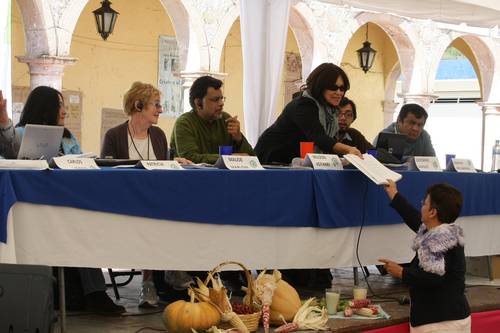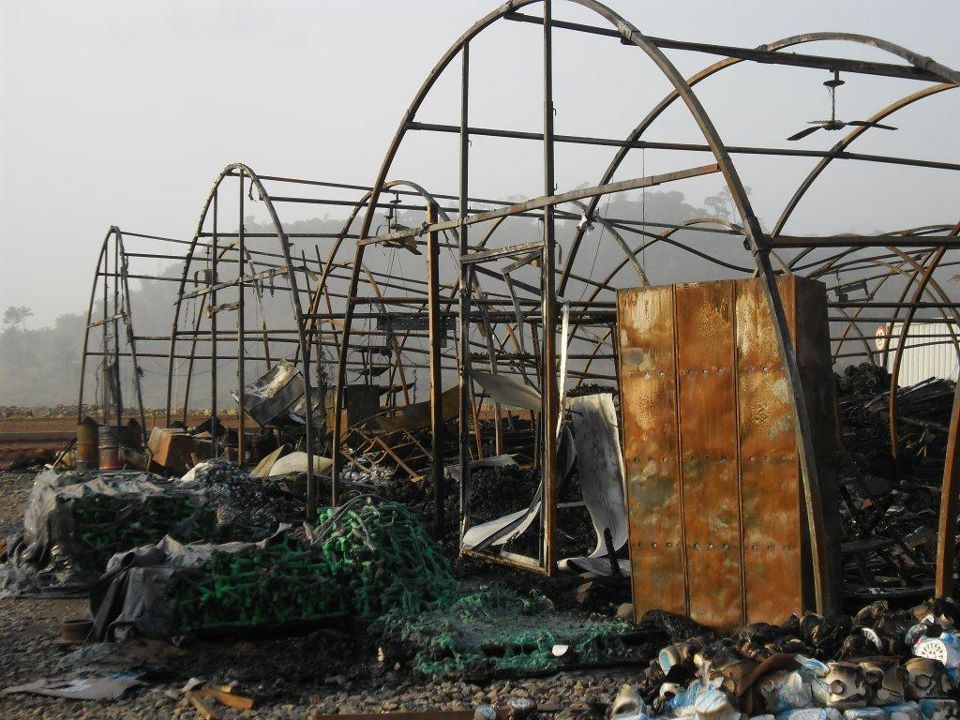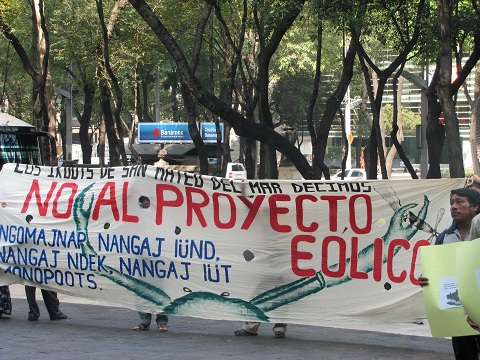
by Deep Green Resistance News Service | Nov 14, 2012 | Colonialism & Conquest, Indigenous Autonomy, Protests & Symbolic Acts
By Daniela Pastrana / Inter Press Service
“What do we stand to lose because of the dam? We will lose everything!” said Maria Abigail Agredani, a member of the committee for this indigenous community in the western Mexican state of Jalisco, reporting the damage that will be caused by the hydroelectric complex being built nearby.
“We will lose the right to life, our culture, traditions, peace, happiness and freedom, our burial sites and our dead, the square, the Christ of Temaca that we love so much, the Agave temacapulinensis plant, the Verde river and 14 centuries of our people’s history,” said Agredani.
She is a member of the movement to “Save Temacapulín, Acasico and Palmarejo,” small towns that will be completely submerged if the El Zapotillo dam is completed.
Temacapulín, a town of 1,500 people in a kind of bowl surrounded by four hills, hosted a pre-hearing this week about dams by the Permanent People’s Tribunal (PPT), which has held sessions in this country since October 2011.
After listening to the testimonies of people from nine communities that have fought the construction of hydropower complexes in five of the country’s provinces, the members of the PPT issued their verdict Wednesday Nov. 8, condemning the Mexican government and demanding the definitive cancellation of all the hydroelectric megaprojects.
“In no case has the right to consulting with and providing information to the affected communities been respected,” said one of the tribunal judges, Monti Aguirre, as she read out the verdict, which maintains that the procedures have been characterised by “systematic and continued violation of individual and collective economic, social and cultural rights of individuals and communities under threat.”
The PPT was founded in 1979 in the Italian city of Bologna, inspired by Lellio Basso, a lawyer and political leader. It is an international ethical tribunal that seeks to try cases in which crimes against humanity are denounced. Although its rulings are non-binding, they carry moral weight.
The Mexican PPT will conclude its work in 2014, at a final hearing which will review the verdicts of all the pre-hearings held during three years of trials of the Mexican state, on issues such as the dirty war and human rights, migration and forced displacement, femicide (gender-related murder) and gender violence, and workers’ rights.
Its work also includes matters related to attacks on maize and food sovereignty, environmental destruction, disinformation, censorship and violence against journalists.
At this pre-hearing about dams, which is included in the panel on environmental destruction, Miloon Kothari of India, a former United Nations Special Rapporteur on the right to adequate housing, and Professor Carlos Bernardo Vainer of the Federal University of Rio de Janeiro, were invited to act as international judges.
Maude Barlow, a Canadian activist for the right to water, and Monti Aguirre, the Latin America programme coordinator for International Rivers, were also invited.
Local experts Francisco López Bárcenas, an indigenous rights lawyer, Luis Daniel Vázquez, coordinator of the doctoral programme in social sciences at the Latin American Faculty of Social Sciences, and Patricia Ávila of the Ecosystems Research Centre at the National Autonomous University of Mexico also served on the PPT.
In an interview with IPS, Vainer emphasised that a constant feature of complaints from these communities is the lack of information and consultation, and indeed even disinformation that appears to be premeditated on the part of the federal government.
“People are not given adequate, timely information. This seems to be a general complaint,” he said.
The problem, he said, is how each of these cases is connected with the global market. He noted that the links between the dam-building industry and large energy-consuming industries with the financial sector result in emerging economies importing technologically obsolete projects in their efforts to develop.
“To supply people’s energy needs, large dams are not needed, because megaprojects do not serve local development but industrial centres. But how much is energy worth, and what is the value of a nation, a culture or a people? There is no possible comparison,” he said.
In the view of López Bárcenas, the pre-hearing clearly established that the outgoing Mexican government of conservative President Felipe Calderón is “plundering communities” and granting concessions for exploiting natural resources to powerful groups.
“Public policies are promoting the stripping of resources, not the development of communities, and those resources are passed on to other sectors, like mining, hydropower, wind farms and tourism,” he said.
One of the most worrying cases presented at the pre-hearing was that of the Arcediano dam, also in Jalisco. The project is meant to supply water to Guadalajara, the state capital.
If the plan had gone ahead, the village of Arcediano would have ended up entirely underwater. However, in 2009 it was cancelled before completion. But the former residents had to move to small houses in resettlement communities on the outskirts of the state capital.
Guadalupe Lara, who was the last person to leave her home, is now about to publish a book about her struggle titled “Yo vi a mi pueblo morir” (I saw my village die). She told IPS it is “very sad and frustrating to see how those who ought to look after us are robbing us instead.”
Read more from Inter Press Service: http://www.ipsnews.net/2012/11/peoples-tribunal-defends-native-villages-from-dams/

by Deep Green Resistance News Service | Nov 13, 2012 | Indigenous Autonomy, Property & Material Destruction, Reclamation & Expropriation, Worker Exploitation
By Agence France-Presse
Work on Brazil’s controversial $13 billion Belo Monte mega-dam ground to a halt Monday after protesters torched buildings at three dam construction sites over the weekend, the developer said.
Saturday, “a group of 30 people set fire to prefab structures at the Pimental site. They went into the cafeteria, destroyed everything and robbed the till” before setting it ablaze, said Fernando Santana, spokesman for builders Consorcio Constructor Belo Monte (CCBM).
And late Sunday, groups of 20 people set structures ablaze at Canais and Diques, two other dam construction sites, said Santana.
“On Monday, as a precautionary security measure, all activities were suspended at the construction site,” said Santana, suggesting that “vandals” might be trying to derail salary renegotiation under way.
The state-owned Norte Energia hired CCBM to build the dam, which is set to be the world’s third largest when it has been completed. Between 12,000 and 13,000 workers would be employed at the site on two shifts, Santana said.
The incidents broke out after CCBM proposed a seven percent wage hike to the workers in an area where the inflation rate is at 30 percent, said Xingu Vivo, a non-governmental group opposing the dam.
On October 9 protesters — 150 natives and local fishermen — interrupted dam construction, accusing Norte Energia of backtracking on accords signed in June when people occupied the Pimental area for three weeks.
Indigenous groups fear the dam across the Xingu River, a tributary of the Amazon, will harm their way of life. Environmentalists have warned of deforestation, greenhouse gas emissions and irreparable damage to the ecosystem.
The dam is expected to flood some 500 square kilometers (200 square miles) along the Xingu and displace 16,000 people, according to the government, although some NGOs put the number at 40,000 displaced.
The natives want their lands demarcated and non-indigenous people removed from them, as well as a better healthcare system and access to drinking water.
Expected to produce 11,000 megawatts of electricity, the dam would be the third biggest in the world, after China’s Three Gorges facility and Brazil’s Itaipu Dam in the south.
It is one of several hydroelectric projects billed by Brazil as providing clean energy for a fast-growing economy.
“Avatar” director James Cameron and actress Sigourney Weaver support dam opponents, drawing parallels with the natives-versus-exploiters storyline of their blockbuster Hollywood movie.
From Bangkok Post: http://www.bangkokpost.com/news/world/320956/trouble-at-brazil-mega-dam-stops-construction-for-now

by Deep Green Resistance News Service | Nov 5, 2012 | Colonialism & Conquest, Indigenous Autonomy, Lobbying, Obstruction & Occupation
By Jennifer M. Smith / Upside-Down World
More than five centuries after Colombus’ arrival in the Americas, the invasion of European powers continues to threaten traditional ways of life in indigenous communities in Mexico. The conflict against the corporate takeover of the ancestral lands of the Huave, or Ikoots people, in the Isthmus of Tehuantepec in Oaxaca is just one of the struggles continuously being played out in the face of trans-national development policies such as Plan Puebla Panama (now known as Proyecto Mesoamerica).
The Ikoots people of Oaxaca have inhabited the Isthmus of Tehuantepec for more than 3000 years, pre-dating the better-known Zapotec culture in Oaxaca. They are a fishing society that depends on the ocean for their livelihood; the Ikoots peoples’ history is so integrated with the sea that they are also known as Mareños (“Oceaners”). Now Ikoots communities are struggling to defend their ancestral lands from multinational corporations who want to build wind turbines in the water along the coast, in the very ocean that has supported their way of life for centuries.
In April of 2004, the United States Department of Energy (DOE) and the US Agency for International Development (USAID) sponsored a study to accelerate the development of wind projects in the state of Oaxaca, which found that the best area for wind project development was in the Isthmus of Tehuantepec, in the heart of the ancestral Ikoots territory. [1]
The proposed Parque Eolico San Dionisio (San Dionisio Wind Park), a wind farm to be constructed in the ocean along the coast, would consist of 102 wind turbines in the water outside the town of San Dionisio del Mar (and 30 more outside neighboring Santa Maria del Mar), two electric transformer substations, six access paths and additional support structures. [2] It would take up 27 kilometers of coastline. The multinationals implementing the project have also informed the Mexican government that they will need to install 5 mooring docks in the Laguna Superior, a coastal lagoon that local communities heavily depend on for fishing. [3]
The construction of wind turbines would have a devastating effect on both Ikoots society and the environment. The community fears that the vibration from the machines would destroy the aquatic life in the area, which is the economic basis of survival for Ikoots communities such as San Dionisio del Mar, San Mateo del Mar and San Francisco del Mar.
“This is the life of the poor: we fish so we can eat and have something to sell, to have a bit of money. They say that now that the wind project is here, they’ll give us money for our land and sea, but the money won’t last forever. We don’t agree with this. How are we going to live?” says Laura Celaya Altamirano, a resident of Isla Pueblo Viejo and the wife of a fisherman. [4] The wind turbines also present a threat to migratory birds and would damage the ecosystems of the local mangrove swamps. In addition, the proposed construction would desecrate Ikoots sacred territory, namely the Isla de San Dionisio and the Barra de Santa Teresa (known by the Ikoots communities as Tileme).
The proposed location for the aquatic wind farm is San Dionisio del Mar, a town of about 5000 residents. The project in San Dionisio is being implemented by a consortium called Mareña Renovable, which consists of the global investment bank Macquarie, based in Australia; the Dutch investment group PGGM; and the Mitsubishi Corporation of Japan. It includes turbines constructed by the Danish Company Vestas Wind Systems, and the involvement of two wind power companies: Grupo Preneal of Spain, and DEMEX of Mexico. The project also has funding from the Inter-American Development Bank. [5] The electricity from the farm would be used to power such corporate giants as FEMSA (based in Mexico, the largest beverage company in Latin America), Coca-Cola, Heineken, and other multinational corporations. [6]
A total disregard for the environment and the livelihoods of local people is par for the course when multinationals step in to take over communal lands for profit. In the Isthmus of Tehuantepec, wind power companies have been exploiting local communities for years, pressuring farmers (most with little formal education) to sign contracts they often don’t understand in order to give up their rights to land that has been held communally for generations. “Oaxaca is the center of communal landownership. There is probably no worse place to make a land deal in Mexico,” says Ben Cokelet, founder of the Project on Organizing, Development, Education, and Research.[7]
Developers held meetings with locals in which model windmills the size of dinner platters were shown; they were led to believe they could continue farming around them. Later they were shocked to see 15-to-20-story turbines constructed, taking up acres of their land. Developers pay the farmers a pittance in exchange for their land, often paying only 1/5th of what they would pay for similar land in the US, or 1/7thof what they would pay the Mexican government for the same land.
And, in a move that exacerbates tension in the community, local leaders are given better deals for their land in order to make the process more appealing to the rest of the population: “The first guy or two that bites gets [$8] per square meter. That’s a hundred times better contract than the other people,” says Cokelet. “But the 98 percent of farmers who sign afterwards sign on for rock-bottom prices. Those one or two people who bite – they don’t bite because they’re lucky. They bite because they know someone. And their job … is to sell it to all their neighbors.” [8]
There are currently 14 wind farms built on land in the Isthmus of Tehuantepec, with 4 under construction in 2012 and 3 more scheduled for 2013. [9] According to the Declaración de San Dionisio del Mar, released on September 17 by the indigenous rights organization UCIZONI (La Unión de Comunidades de la Zona Norte del Istmo – The Union of Communities in the North Zone of the Isthmus), the communities affected by the 14 existing wind farms have not benefited from lower electricity rates; rather, the intention of the farms is clearly to serve the interests of transnational corporations such as Coca-Cola, Walmart, Nestle, Bimbo and others. [10]
The wind turbines in San Dionisio are the first proposed turbines to be built in the sea. Ikoots communities would not even benefit from the jobs created by the wind turbines; the construction and maintenance of the wind turbines would most certainly be given to employees of the multinational corporations funding the project, not to local fishermen.
The Ikoots community of San Dionisio del Mar did not consent to this project, nor were they even informed that it was under consideration. The International Labour Organization, a United Nations agency dealing with labor rights, specifically states in its Convention 169 (Convention on Indigenous and Tribal Peoples) that “special measures… be adopted to safeguard the persons, institutions, property, labour, cultures and environment of these [indigenous] peoples. In addition, the Convention stipulates that these special measures should not go against the free wishes of indigenous peoples.” Mexico ratified this convention in 1990. [11] In this case, there was no public forum or announcement regarding the construction of the wind farms.
“A common practice of foreign businesses is to ‘buy’ [via bribes] the local PRIista authorities,” says Carlos Beas Torres, a leader and co-founder of UCIZONI and a well-known activist for indigenous rights. In 2004, Alvaro Sosa, the then-president of the “comisariado de bienes comunales” (essentially, the commissary for the territory held in common by the community), signed a preliminary contract renting a section of land to the Spanish corporation Preneal without the knowledge of the town’s residents. The 30-year contract that gave the multinationals access to 1643 hectares of land; Sosa did not inform the community of this action and accepted bribes in exchange for his consent.[12]
The people of San Dionisio del Mar did not find out about the existence of this contract until late in 2011, when the municipal president, Miguel López Castellanos (a member of the Partido Revolucionario Institucional, or PRI), again without consulting the community gave his permission for the consortium Mareña Renovables to begin construction of wind turbines in exchange for a payment of between 14-20 million pesos (between $1-1.5 million USD). The multinationals claim to have given him 20 million pesos, but Lopez Castellanos only admits to receiving 14 million pesos. [13]
Upon this discovery, the residents of San Dionisio held a public assembly where they demanded that the municipal president revoke his consent for the wind farm, which he refused to do. In February, representatives from the community met with DEMEX in Mexico City to request that the contract process start over, but were turned down. [14] Thus the struggle for control of the Ikoots’ ancestral land began.
Not surprisingly, an intense resistance movement against the wind farm has surged in San Dionisio del Mar. The townspeople have initiated a legal battle in the Tribunal Unitario Agrario (Agrarian Unitary Tribunal), the government agency in charge of settling agrarian disputes, in an attempt to nullify the contract. However they are also taking direct action in an attempt to defend their land.
In late January 2012, community members took possession of the municipal palace in San Dionisio in protest, ejecting municipal president Miguel López Castellanos, creating the Asamblea General del Pueblo de San Dionisio (General Assembly of the People of San Dionisio), and declaring themselves in resistance.[15] In April, the San Dionisio communal assembly prevented employees of the multinationals from laying out access roads in the Barra de Santa Teresa, and set up a permanent watch to make sure the contractors do not return. [16]
In September, community members organized a national encuentro (or gathering) in San Dionisio, with the participation of around 300 people from 25 different indigenous and activist organizations from 6 different states in Mexico.[17] The intent of the encuentro was not only to raise awareness on what was happening on Ikoots land, but also to create a large-scale national plan of action to resist megaprojects such as the wind farms. “It’s practically a second Spanish Conquest; they’re coming again to snatch our land with a contract that is completely advantageous, draconian and in violation of our rights as indigenous people,” says Jesús García Sosa, a representative of the Asamblea General. [18]
The resistance movement continues to grow despite threats and intimidation, as well as actual physical attacks on community members committed by opposing political factions. The general consensus is that these factions are being paid by the multinationals involved to hamper resistance to the development project. On August 25, a representative of the Asamblea General named Moisés Juárez Muriel was brutally attacked while walking home in the evening by two men who beat him with stones.
He was taken by two compañeros in resistance to the IMSS-Complamar clinic, where he was refused treatment because the clinic was under control of the municipal president. [19] In mid-September, immediately after the conclusion of the encuentro in support of the Ikoots community members in resistance, a group of heavily armed individuals surrounded the municipal palace that the community members were occupying, pointing guns at and intimidating the people who were guarding the building. [20]
Resistance movement leaders have also received public death threats from political parties and anonymous sources. On October 6, a group of PRI agitators marched through San Dionisio, making specific death threats against Bettina Cruz Velazquez, a well-known human rights activist and founder of the Asamblea de los Pueblos Indígenas del Istmo de Tehuantepec en Defensa de la Tierra y el Territorio (Assembly of Indigenous Peoples of the Isthmus of Tehuantepec in Defense of Land and Territory).
Cruz Velazquez is deeply involved in the resistance movement against the wind project. Human rights groups in Mexico have formally asked the governor of Oaxaca, Gabino Cué Monteagudo, to guarantee her safety. [21] Carlos Beas Torres of UCIZONI has received threatening phone calls for his public stance in opposition of the project. [22]
In some cases, attempts to stop resistance support have led to clashes. In mid-October, two organizations, El Frente por la Defensa de la Tierra (The Front for the Defense of the Earth) and UCIZONI sent a caravan of support attempting to bring food and supplies to the community in resistance in San Dionisio. A blockade was set up by armed PRIista sympathizers of the municipal president, Miguel López Castellanos, to keep the caravan from passing. [23] A violent confrontation ensued.
“The store owners in San Dionisio belong to the PRI and refuse to sell food to the people resisting the wind project,” says Carlos Alberto Ocaña, whose father (a native of San Dionisio) was the driver of the first truck in the supply caravan. “When the caravan approached the town, it was stopped by a blockade of about 70 people. They had guns, machetes, and gasoline for setting the cars on fire. My father was in the first truck with five other people. They PRIistas in the blockade pulled them out of the truck and started beating them.”
The police eventually arrived, but the caravan was unable to pass the barricade to reach San Dionisio and eventually it was forced to turn back without delivering the supplies.
On October 17 and 18, members of the Asamblea General of San Dionisio, UCIZONI, la Asamblea de Pueblos Indígenas del Istmo en Defensa de la Tierra y el Territorio, la Alianza Mexicana por la Autodeterminación de los Pueblos (Mexican Allaince for the Self-Determination of the People, AMAP), and a half dozen other groups held protests in Mexico City. They held rallies in front of the Interamerican Development Bank, Mitsubishi, Coca-Cola, Vestas, and the Danish embassy. Their goal was twofold: to impede the construction of the wind park in San Dionisio, but also to publicly denounce the environmental and cultural damage that threatens the Ikoots communities of the Isthmus.
They were received and allowed to present written complaints at the Interamerican Development Bank, Vestas, and the Danish embassy. oca-Cola-FEMSA refused to meet with them. [24] As of this writing, the Ikoots communities’ struggle against corporate takeover continues; in November representatives of the community will travel to the Netherlands, with the support of Dutch unions, to present a letter of protest in person to the Dutch investment company PGGM.
In the words of Asamblea General representative Jesús García Sosa, “We will not allow that business and government to yet again displace us from our territory, which symbolizes our very life, our mother, our father; we can’t sell it to them or put a price on it, much less in exchange for projects of death and plunder.” [25]
On October 30th, President Felipe Calderon Hinojosa, who was in Oaxaca to inaugurate a new highway, also travelled to inaugurate the Piedra Larga Wind Park. Calderon saluted the project, citing it as a solution to poverty and climate change, and mentioning the “additional income” the residents of the town Unión Hidalgo would receive for allowing the turbines to be installed on their communal land.
Meanwhile, 300 meters outside the park, theirn entrance blocked by national police, nearly 200 people from different communities in the region including San Mateo del Mar, San Dionisio del Mar, San Francisco del Mar, Unión Hidalgo, Juchitán, Santa María Xadani and the UCIZONI, protested the park’s opening. [26]
1. Noticias de Oaxaca, Oct. 14 2012.
2. Noticias de Oaxaca, Aug. 20 2012.
3. Noticias de Oaxaca, Apr. 21 2012.
4. Noticias de Oaxaca, Aug. 20 2012.
5. Recharge News, Mar. 12 2012.
6. Noticias de Oaxaca, Apr. 23 2012.
7. Christian Science Monitor, Jan. 26 2012.
8. Ibid
9. Noticias de Oaxaca, Oct. 11 2012.
10. UCIZONI statement, Sept. 17 2012.
11. International Labor Organization Convention 169.
12. La Jornada, Aug. 23 2012.
13. Noticias de Oaxaca, Aug. 20 2012.
14. Christian Science Monitor, Feb. 28 2012.
15. El Sol del Istmo, Jan. 30 2012.
16. Noticias de Oaxaca, Apr. 21 2012.
17. Despertar de Oaxaca, Sept. 28 2012.
18. Noticias de Oaxaca, Aug. 20 2012.
19. Quadratin Oaxaca, Oct. 9 2012.
20. Ibid.
21. E-Oaxaca, Oct. 15 2012.
22. Quadratin Oaxaca, Oct. 9 2012
23. E-Oaxaca, Oct. 11 2012. (Link at e-oaxaca.mx/noticias/nacional/13411-impide-edil-de-san-dionisio-del-mar-ingreso-de-caravana-contra-empresas-eolicas.html no longer works)
24. La Jornada, Oct. 17 2012:
25. Noticias de Oaxaca, Aug. 20 2012.
26. Eco Noticias Huatulco. Oct 30, 2012.
From Upside Down World: http://upsidedownworld.org/main/mexico-archives-79/3952-indigenous-communities-in-mexico-fight-corporate-wind-farms

by Deep Green Resistance News Service | Oct 31, 2012 | Colonialism & Conquest, Indigenous Autonomy, Toxification
By Darrin Mortenson / Alianza Arkana
Even as indigenous people struggle to cope with current levels of contamination and illness caused by years of oil production in the Amazon, the governments of Peru and Ecuador are preparing to sell off even more Amazonian territory to the oil industry in coming months.
Starting in November, Peru’s state-run leasing agency Petroperu plans to start auctioning licenses to 36 new oil blocks for exploration, 19 of them in the northern region of Loreto. Just across the border, Ecuador is set to lease at least 13 blocks on or near waterways that eventually flow south into Peru and join the Amazon River.
Many of the blocks overlap or abut protected areas and indigenous territories and threaten the forests and rivers that indigenous people and other river people depend on for their lives.
Indigenous groups are rallying to stop their governments’ plans, and some talk of making a stand for a total moratorium on all exploration until both countries come up with a regional environmental plan.
“Oil production is an activity that definitely alters our territory, our environment, our health and our culture,” said Alfonso Lopez Tejada, leader of the federation of 57 indigenous Kukama communities along the Maranon river region in Peru, where three new lots overlap Kukama communities and threaten the famous Pacaya Samiria National Reserve.
“Again they impose these lots on us just as they did not consult us when they leased our territories before,” Lopez said.
In Ecuador, indigenous groups are planning demonstrations and marches to protest the new round of concessions begin on November 28.
“We are defending our land. We won’t allow oil activity,” said Franco Viteri, president of a Confederation of Indigenous Nationalities of the Ecuadorean Amazon (Confeniae), according to a recent article in the Wall Street Journal.
Ecuadorian indigenous leaders say they will make an appeal to the country’s Constitutional Court.
From Alianza Arkana





